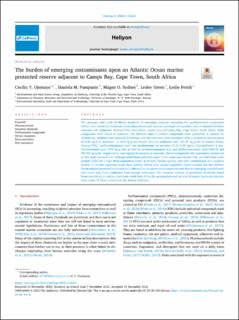| dc.contributor.author | Ojemaye, Cecilia Y. | |
| dc.contributor.author | Pampanin, Daniela Maria | |
| dc.contributor.author | Sydnes, Magne Olav | |
| dc.contributor.author | Green, Lesley | |
| dc.contributor.author | Petrik, Leslie | |
| dc.date.accessioned | 2023-01-10T08:28:21Z | |
| dc.date.available | 2023-01-10T08:28:21Z | |
| dc.date.created | 2023-01-08T14:36:33Z | |
| dc.date.issued | 2022 | |
| dc.identifier.citation | Ojemaye, C. Y., Pampanin, D. M., Sydnes, M. O., Green, L., & Petrik, L. (2022). The burden of emerging contaminants upon an Atlantic Ocean marine protected reserve adjacent to Camps Bay, Cape Town, South Africa. Heliyon, e12625. | en_US |
| dc.identifier.issn | 2405-8440 | |
| dc.identifier.uri | https://hdl.handle.net/11250/3042169 | |
| dc.description.abstract | The presence and levels of fifteen chemicals of emerging concerns, including five perfluorinated compounds (PFCs), two industrial chemicals, seven pharmaceuticals and one personal care product, were evaluated in biota, seawater and sediments obtained from near-shore coastal zone in Camps Bay, Cape Town, South Africa. Eight compounds were found in seawater, and between nine to twelve compounds were quantified in marine invertebrates, sediment and seaweed. Diclofenac was the prevalent pharmaceutical with a maximum concentration of 2.86 ng/L in seawater, ≥110.9 ng/g dry weight (dw) in sediments and ≥67.47 ng/g dw in marine biotas. Among PFCs, perfluoroheptanoic acid was predominant in seawater (0.21–0.46 ng/L). Accumulation of perfluorodecanoic acid (764 ng/g dw) as well as perfluorononanoic acid and perfluorooctanoic acid (504.52 and 597.04 ng/g dw, respectively) was highest in samples of seaweed. The environmental risk assessment carried out in this study showed that although individual pollutants pose a low acute and chronic risk, yet individual compounds each had a high bioaccumulation factor in diverse marine species, and their combination as a complex mixture in marine organisms might have adverse effects upon aquatic organisms. Data revealed that this Atlantic Ocean marine protected environment is affected by the presence of numerous and diverse emerging contaminants that could only have originated from sewage discharges. The complex mixture of persistent chemicals found bioaccumulating in marine organisms could bode ill for the propagation and survival of marine protected species, since many of these compounds are known toxicants. | en_US |
| dc.language.iso | eng | en_US |
| dc.publisher | CellPress | en_US |
| dc.rights | Navngivelse 4.0 Internasjonal | * |
| dc.rights.uri | http://creativecommons.org/licenses/by/4.0/deed.no | * |
| dc.title | The burden of emerging contaminants upon an Atlantic Ocean marine protected reserve adjacent to Camps Bay, Cape Town, South Africa | en_US |
| dc.title.alternative | The burden of emerging contaminants upon an Atlantic Ocean marine protected reserve adjacent to Camps Bay, Cape Town, South Africa | en_US |
| dc.type | Peer reviewed | en_US |
| dc.type | Journal article | en_US |
| dc.description.version | publishedVersion | en_US |
| dc.rights.holder | The author | en_US |
| dc.subject.nsi | VDP::Matematikk og Naturvitenskap: 400 | en_US |
| dc.source.volume | 8 | en_US |
| dc.source.journal | Heliyon | en_US |
| dc.source.issue | 12 | en_US |
| dc.identifier.doi | 10.1016/j.heliyon.2022.e12625 | |
| dc.identifier.cristin | 2102741 | |
| cristin.ispublished | true | |
| cristin.fulltext | original | |
| cristin.qualitycode | 1 | |

